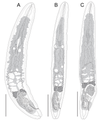Category:Media from Cutmore & Cribb - 10.1051/parasite/2021072
Authors: Scott C. Cutmore and Thomas H. Cribb
- (2021). "A new order of fishes as hosts of blood flukes (Aporocotylidae); description of a new genus and three new species infecting squirrelfishes (Holocentriformes, Holocentridae) on the Great Barrier Reef". Parasite 28: 76. DOI:10.1051/parasite/2021072.
| Upload media | |||||
| Instance of | |||||
|---|---|---|---|---|---|
| Main subject |
| ||||
| Author |
| ||||
| Published in | |||||
| Copyright license | |||||
| Publication date |
| ||||
| |||||
Abstract
A new genus and three new species of blood flukes (Aporocotylidae) are described from squirrelfishes (Holocentridae) from the Great Barrier Reef. Holocentricola rufus n. gen., n. sp. is described from Sargocentron rubrum (Forsskål), from off Heron Island, southern Great Barrier Reef, and Lizard Island, northern Great Barrier Reef, Australia. Holocentricola exilis n. sp. and Holocentricola coronatus n. sp. are described from off Lizard Island, H. exilis from Neoniphon sammara (Forsskål) and H. coronatusItalic text from Sargocentron diadema (Lacepède). Species of the new genus are distinct from those of all other aporocotylid genera in having a retort-shaped cirrus-sac with a distinct thickening at a marginal male genital pore. The new genus is further distinct in the combination of a lanceolate body, X-shaped caeca, posterior caeca that are longer than anterior caeca, a single, post-caecal testis that is not deeply lobed, a post-caecal, post-testis ovary that is not distinctly bi-lobed, and a post-ovarian uterus. The three new species can be morphologically delineated based on the size and row structure of the marginal spines, as well by total length, oesophagus and caecal lengths, and the position of the male genital pore, testes and ovary relative to the posterior extremity. The three species of Holocentricola are genetically distinct from each other based on cox1 mtDNA and ITS2 rDNA data, and in phylogenetic analyses of 28S rDNA form a well-supported clade sister to species of Neoparacardicola Yamaguti, 1970. This is the first report of aporocotylids from fishes of the family Holocentridae and the order Holocentriformes.
Media in category "Media from Cutmore & Cribb - 10.1051/parasite/2021072"
The following 4 files are in this category, out of 4 total.
-
Parasite210126-Figure 1 Holocentricola (Digenea, Aporocotylidae).png 8,409 × 6,142; 1.11 MB
-
Parasite210126-Figure 2 Holocentricola (Digenea, Aporocotylidae).png 6,024 × 7,087; 8.95 MB
-
Parasite210126-Figure 3 Holocentricola (Digenea, Aporocotylidae).png 8,031 × 3,780; 1.91 MB
-
Parasite210126-Figure 4 Holocentricola (Digenea, Aporocotylidae).png 6,142 × 9,449; 1.61 MB




